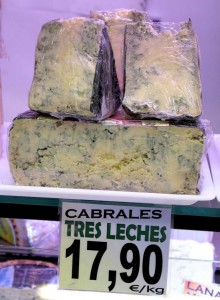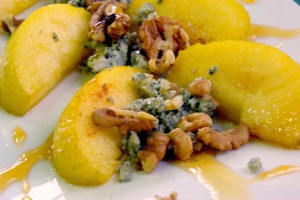 We saw many more cows than sheep or even goats as we drove the twisting mountain roads through the Picos de Europa mountain range last spring. Although the Principality of Asturias is the oldest of Iberia’s former kingdoms, the steep green mountains looked more like Switzerland than Spain.
We saw many more cows than sheep or even goats as we drove the twisting mountain roads through the Picos de Europa mountain range last spring. Although the Principality of Asturias is the oldest of Iberia’s former kingdoms, the steep green mountains looked more like Switzerland than Spain.
Cows may have predominated, but milk from all three dairy animals goes into Cabrales, possibly the most pungent blue cheese in Europe. When we stopped for lunch in Las Arenas de Cabrales, we made sure we got the blues. The cheese is made by shepherds in the nearby hills, but Las Arenas (pop 797) is the market town. In Sidrería Calluenger (tel: 985-646-441), a hard-cider bar on Plaza Castaneu, we enjoyed a sumptuous lunch of stuffed red piquillo peppers simmered in a Cabrales cream sauce, along with a plate of fried apples, Cabrales, and walnuts drizzled with honey.
Fortunately, we can buy Cabrales at home, and the cheese pairs beautifully with New England heirloom apples. We tried making this dish with several varieties, finally settling on Golden Delicious as the most authentic, with Opalescent (a beautiful apple with skin like a red-and-gold starry night) a close second.

CABRALES AND APPLES
Serves 2 as a light lunch or 4 as a combined cheese/dessert course.
Ingredients
1 tablespoon unsalted butter
2 Golden Delicious apples, cored and cut into eighths (skin intact)
4 ounces Cabrales cheese, crumbled
1/2 cup lightly toasted and coarsely chopped walnuts
2 tablespoons honey
Directions
1. Melt butter in 10-inch skillet over medium heat. Add apples and gently saute until lightly speckled with brown spots. Turn over and lightly brown other side.
2. Arrange apples on plate, intermingling with crumbled Cabrales and walnut pieces. Drizzle with honey and serve.
